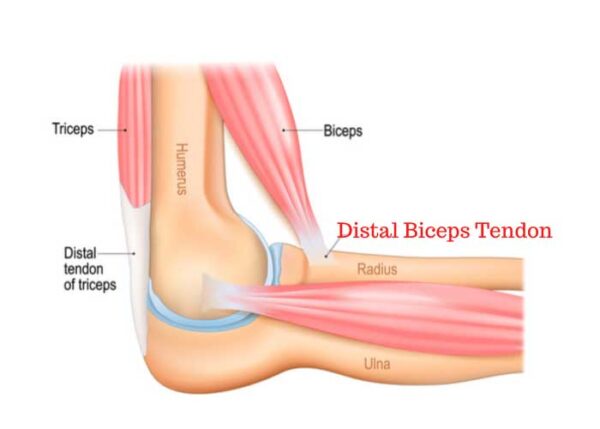Distal Biceps Tendon Tear Specialist

Are you an athlete who participates in sports that involve heavy lifting? If so, you may be at risk of tearing your distal biceps tendon. A distal biceps tear can occur from a blunt force trauma or excessive loading on the joint. Distal biceps tendon tear specialist, Doctor Riley J. Williams, provides diagnosis and both surgical and nonsurgical treatment options for patients in Manhattan, Brooklyn, New York City and surrounding areas who have suffered a distal tendon biceps tear. Contact Dr. Williams’ team today!
What is a distal biceps tendon tear?
The biceps muscle is located on the front part of the upper arm; this muscle is the “Popeye” muscle that bends bending the elbow and rotates the forearm. A distal biceps tendon tear is a tear in the tendon that attaches the biceps muscle to the radius (bone in the forearm). Tendons are strong bands of fibrous tissue. The biceps muscle has three tendons: two proximal and one distal. The proximal tendons originate from the shoulder; the distal tendon attached at the elbow as described above. If there is a partial or complete tear to the distal tendon, patients typically experience anterior elbow pain and weakness. A partial tear means there is damage to the tendon, but the tendon has not fully detached from the bone or ruptured in the tendon mid-substance. A complete tear means the tendon is fully detached from the bone or fully disrupted. Partial tears can occur from repetitive trauma or chronic tendonitis. Complete tears are more common, and usually follow a heavy load that is applied to the elbow. Traumatic distal biceps tendon injuries occur when the biceps is under tension and the elbow is forced into a straight position; weightlifting is a risk factor for these types of injuries. Dr. Riley J. Williams, orthopedic elbow specialist, serving Manhattan, Brooklyn, New York City, NY and surrounding areas, has extensive experience in treating a distal biceps tendon tears and other elbow injuries.

What are the symptoms of a distal biceps tendon tear?
Individuals in the New York area who experience a distal biceps tendon tear often report the following symptoms:
- Pain in the anterior elbow
- Popping sensation in the elbow
- Biceps muscle balling up near the upper arm
- Swelling & bruising
- Weakness or an inability to flex the elbow
- A space or gap at the front of the elbow where the tendon has detached
How is a biceps tendon tear diagnosed?
Dr. Williams will inquire as to how your injury occurred and will perform a physical examination. He will feel the front of the elbow, checking for the characteristic gap in lower part of the upper arm. He will also test the patient’s ability to rotate the forearm. This action is called supination and is difficult to do if there is a distal biceps tendon tear. Dr. Williams may also order image testing such as x-ray, ultrasound, or MRI. X-rays provide images of the bone and can rule out other injuries. An ultrasound can determine if the biceps tendon has torn, and if it has coiled in the arm. MRIs can also detect a rupture of the distal biceps tendon; MRI also allows Dr. Williams to determine if the tear is partial, or complete.
How is a distal biceps tendon tear treated?
Non-surgical treatment:
Conservative treatment options are usually reserved for partial tears or individuals who would not make good candidates for an operation, such as elderly patients. The tenets of the nonoperative treatment of distal biceps tendon ruptures include avoiding heavy lifting, taking NSAIDs (non-steroidal anti-inflammatories – i.e., ibuprofen), and seeing a physical therapist for the purposes of strengthening surrounding muscles of the elbow and reestablishing normal range of motion. Complete tears are not typically treated nonoperatively.
Surgical treatment:
Surgery should be performed within the first 1-2 weeks after the injury is sustained. During surgery, Dr. Williams reattaches the torn tendon to the bone (radius). Dr. Williams typically uses a single incision technique; the approach is made from the front of the elbow. The tendon is reattached by using anchors and stitches that are placed in small holes drilled in the radius bone. After a week in a splint, patients are placed in a movable elbow hinged brace. Most patients will start moving during week 2 following surgery. All patients will participate in physical therapy for approximately 6-8 weeks following the repair. Full recovery takes 3-6 months.
For more information on a distal biceps tendon tear and the treatment options available, please contact the office of Riley J. Williams, MD, orthopedic elbow specialist serving Manhattan, Brooklyn, New York City, NY and surrounding areas.
Locations
610 W 58th Street
New York, NY 10019
148 39th Street, 7th Floor
Brooklyn, NY 11232



